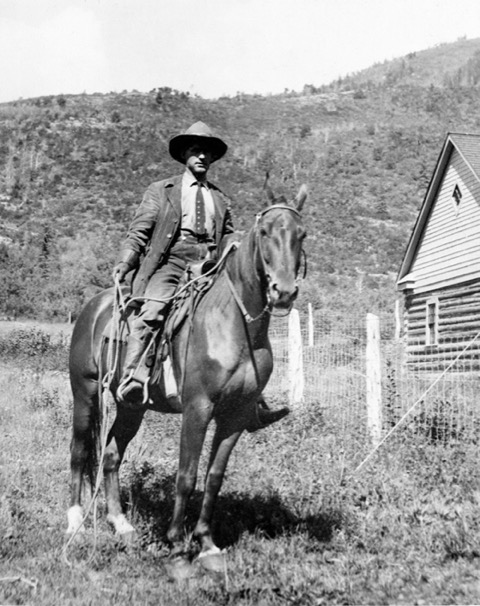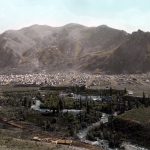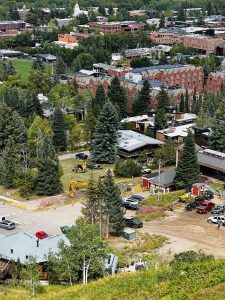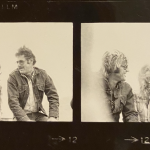Willoughby: Leonard Shoemaker — important early Forest Ranger

Aspen Historical Society/Courtesy photo
Many of the trails you may enjoy were established/created around a century ago. They were purposefully planned and built by Leonard Shoemaker, the local U.S. Forest Service ranger, who knew every inch of this district.
Shoemaker was also the first local to write a history of Aspen. He began writing an autobiography, “Saga of a Forest Ranger,” after he retired. At the time he was living in Denver. He followed that in 1959 with “Roaring Fork River Valley” and then revised that and penned “Pioneers of the Roaring Fork.” In that book, he recounted stories he had picked up from Aspen’s pioneers and some of his personal experiences in the valley.
He also had a weekly radio show on KOA in 1941 called, “Tales of the Trail,” where he told stores of his and other rangers experiences, fighting forest fires, building trails, and even putting up phone lines.
The Mount of the Holy Cross Forest Reserve was created in 1905 and signed into law by President Roosevelt. Soon after, the office for it was opened in Glenwood. In 1909, a second office was opened in Aspen. Shoemaker came to the Roaring Fork Valley as a 5-year-old child in 1885. He lived in Carbondale for many years before getting a job in 1913 with the Sopris Forest, then in 1914 he became a ranger for the Holy Cross Forest stationed in Aspen and a substation in Woody Creek in 1915.
About 10 years into his two-decade ranger career in the Aspen area, he began work on six trails. One was a trail between Maroon and Snowmass that involved Buckskin Pass. One connected Conundrum gulch to the Hot Springs. A trail was built to connect New York gulch with Lincoln gulch road. In the same area, a trail to connect Grizzley gulch with Lincoln gulch road was constructed. And he created a trail that went up Hunter Creek.
Those projects totaled about 15 miles and, according to Shoemaker, they would provide, “a great convenience to sightseers, prospectors, and sheep herders enabling them to negotiate the timbered sections of and reach the open space above timberline.
The longest, hardest to accomplish trail, dubbed the panorama trail, connects some existing trails so you could hike from Ashcroft to the Conundrum Hot Springs via Electric Pass. Part of the trail had already been built, from the Castle Creek Road to Cathedral Lake, but eight miles more trail was added. Shoemaker formed a crew of: James Gavin, Floyd Hermen, Arther Rogers, George Hutchins, Jakle Hath, and Otis Milled.
Shoemaker, in announcing the trail project, projected that it would, “furnish a hair-raising trip for tourists — end trip with a lake at the end of a day’s trip at the hot springs.”
Shoemaker was instrumental in creating what today is one of the most important connections in the county, a road all the way to Maroon Lake. There was a road up the valley for many years, but it did not go all the way to the lake. The talk about extending it began around the time Showmaker began his work as ranger. He lobbied his superiors and, finally, in 1924, an eight-foot-wide extension was approved, but there was a change in his superiors just after that so nothing happened. He kept at it. Work began for a 16-foot-wide road in 1935 and was completed in 1936. This was a Depression era project with 45 men providing the labor.
Shoemaker transferred to the Boulder area and finished working at the regional office in Denver, retiring 1943. In retirement, living in Denver, he, with John Gilbert, began an unusual Aspen event, an annual picnic gathering of former Aspenites living in the Denver area. The Aspen Times helped promote it. There were usually around 150 who came, one year 207 attended. It appears it continued through 1961.
Tim Willoughby’s family story parallels Aspen’s. He began sharing folklore while teaching at Aspen Country Day School and Colorado Mountain College. Now a tourist in his native town, he views it with historical perspective. Reach him at redmtn2@comcast.net.
Aspen Mountain to be ‘fundamentally changed’ as construction starts near Lift One
Construction is slowly starting for the Chalet Alpina project near the original base of Lift One, bringing the resort “crafted from fables,” as its website puts it, one step closer to reality.









